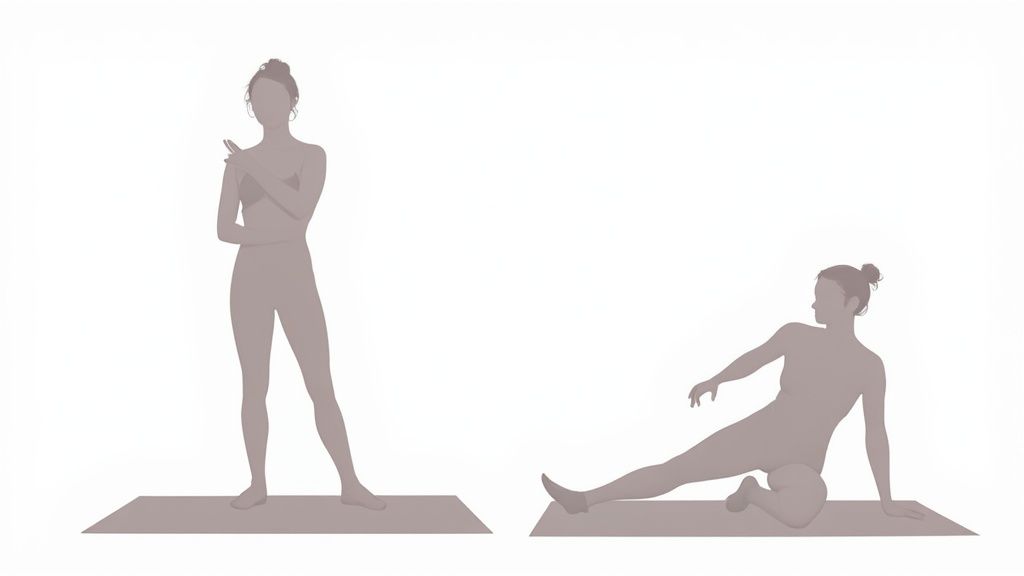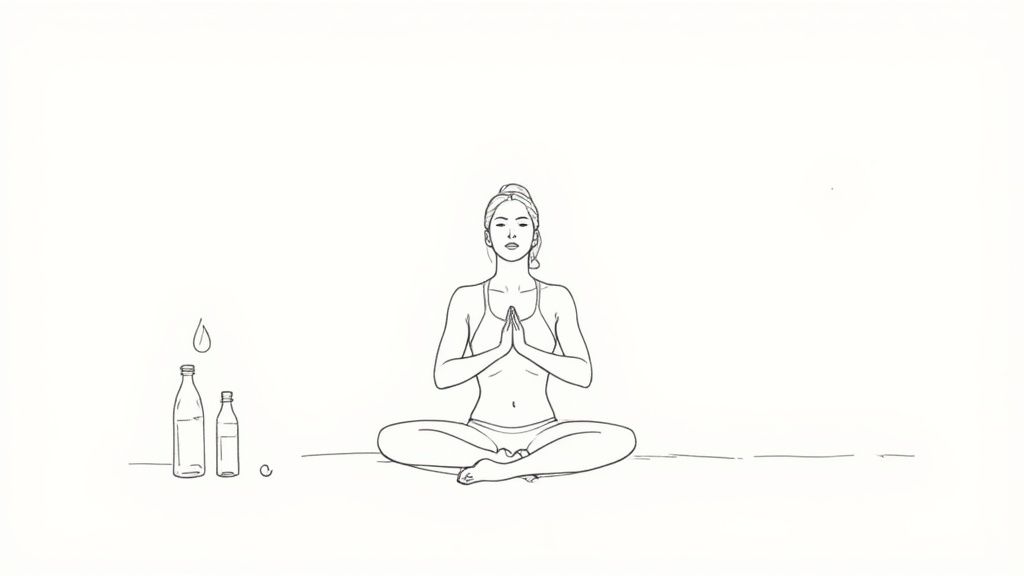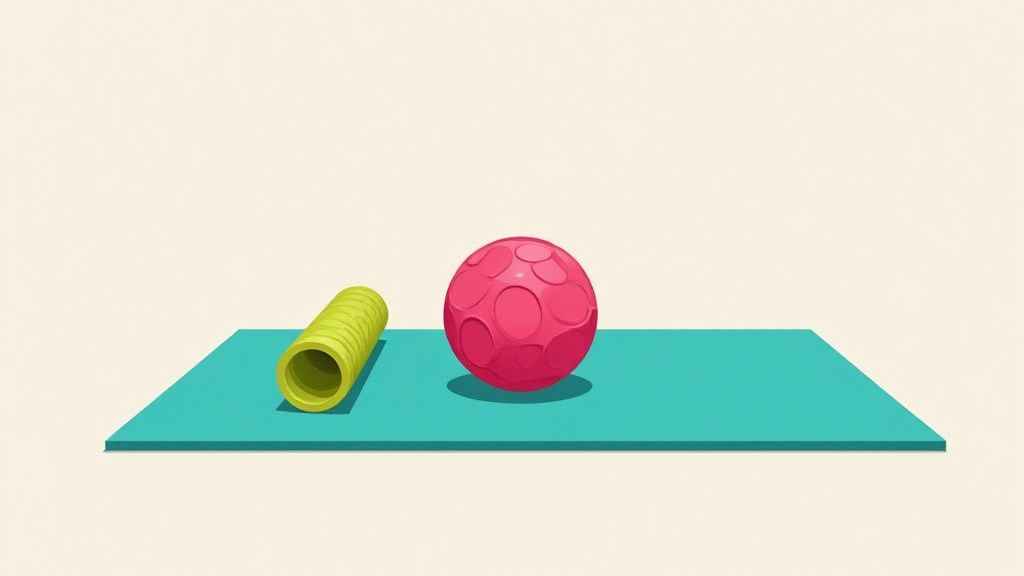You just crushed a tough workout. Your first instinct might be to collapse on the couch, but what you do in the next 10 minutes can make a world of difference in how you feel tomorrow. Learning how to cool down after exercise is simple: it’s all about bringing your heart rate down slowly with some gentle movement, then holding a few key stretches for 5-10 minutes.
This guide will walk you through an effective, equipment-free cooldown that you can do anywhere. Think of it as hitting the "save" button on all your hard work.
What You’ll Need for This Cooldown
The best part? You don't need anything fancy.
- A comfortable space: Just enough room to stand and lie down.
- Your own body: That’s it!
- Optional: A mat for comfort and a water bottle for rehydrating afterward.
Why a Cooldown Is Your Workout's Secret Weapon
It’s easy to think of the cooldown as an optional extra, but it’s really the final, crucial chapter of your workout. After your last rep, your body is still in high gear—heart racing, core temperature up, and blood pumping hard. Stopping suddenly is a jolt to the system.
Easing your body from high intensity back to a resting state helps manage that transition smoothly. This simple step can prevent the sudden drop in blood pressure that sometimes makes people feel dizzy or lightheaded. It’s your way of telling your body, "Okay, the hard work is done; time to start the repair process."
Kickstart Your Muscle Repair
One of the biggest wins from a consistent cooldown is how it helps manage next-day muscle soreness. When you train, your muscles create byproducts. A gentle cooldown helps your body clear them out more efficiently.
- Better Blood Flow: Keeping your body moving gently helps circulate blood, which acts like a cleanup crew, hauling waste products away from your tired muscles.
- Less Soreness: This flushing effect can seriously reduce the dreaded Delayed Onset Muscle Soreness (DOMS), so you're not wincing with every step a day or two later.
- Improved Flexibility: Your muscles are warm and much more pliable right after a workout. This is the absolute best time to do some static stretching to improve your flexibility for the long haul.
This whole idea of recovery isn't just a niche topic anymore. In fact, the global market for post-workout recovery products has ballooned to USD 14.7 billion. That tells you just how seriously athletes and everyday fitness enthusiasts are taking the science of bouncing back. Learn more about the growth in recovery aids.
This infographic breaks down the simple but powerful process of a proper cooldown.

As you can see, the cooldown is the bridge between your maximum effort and your body's recovery, kickstarting the repair process your muscles need to get stronger.
Your Step-by-Step 10-Minute Cooldown Routine
You’ve finished your workout and you're feeling accomplished. Now it's time to honor that effort. This simple, no-equipment routine is designed to bring your body back down to earth gently.

We'll start by letting your heart rate come down naturally, then move into some key static stretches. Remember, your muscles are warm and receptive right now, making it the ideal time to work on flexibility.
The golden rule for these stretches? Ease into them until you feel a comfortable pull, never sharp pain. Aim to hold each stretch for about 20-30 seconds. This is the sweet spot that tells your nervous system it's okay for the muscle to relax and lengthen. It's the core of learning how to cool down after exercise effectively.
The Bare Fitness Cooldown Sequence
Here’s a simple, timed routine to target the major muscle groups you just worked. Just follow along and focus on deep, steady breathing.
This sequence is short, simple, and hits all the major muscles that tend to get tight after a good workout.
Your cooldown isn't just a physical "to-do" item. It's a mental transition. It’s the moment you thank your body for what it just did and set the stage for strong recovery. This is how you build a fitness routine that lasts.
Making this a non-negotiable part of every session will pay off big time. You'll feel less sore, stay mobile, and show up to your next workout feeling ready to go. This is a fundamental part of learning how to cool down after exercise the right way.
Beyond Stretching: Breathing and Hydration

While stretching is key, a truly effective cooldown brings your whole body back to balance. It’s about calming your nervous system just as much as loosening your muscles. Two of the most powerful—and easiest—ways to do this are with focused breathing and smart rehydration.
Think of it this way: your workout puts your body into a "fight or flight" state. Your cooldown's job is to flip the switch to "rest and digest" mode. That’s when the real recovery and muscle repair begins.
Find Your Calm with Deep Breathing
After a tough workout, your breathing is probably fast and shallow, coming from your chest. To kickstart recovery, we want to shift to deep, diaphragmatic breathing—also known as belly breathing. This simple act helps lower stress hormones that spike during intense exercise.
Here's how to do it:
- Find a comfortable spot to lie down or sit. Place one hand on your chest and the other on your belly.
- Inhale slowly through your nose for a four-count. Feel the hand on your belly rise, while the one on your chest stays mostly still.
- Hold for a moment, then exhale slowly through your mouth for a six-count, feeling your belly fall.
- Repeat this for 2-3 minutes. It’s one of the most effective ways to truly cool down after exercise and tell your body the hard work is done.
Rehydrate the Right Way
You lost a lot of fluid through sweat, and now it's time to replace it. Getting properly hydrated is non-negotiable—it helps regulate your body temperature and transports nutrients to your muscles so they can start repairing.
You don't need a complicated formula. A good rule of thumb is to drink 16-24 ounces (about 2-3 cups) of water for every pound of body weight lost during your session. If you’re not weighing yourself, no problem. Just make a point to sip water steadily for the next hour.
Thirst is a surprisingly unreliable indicator. By the time you feel thirsty, you're already on your way to being dehydrated. Get into the habit of drinking water after your workout whether you feel like it or not.
The massive USD 12.8 billion market for post-workout drinks market proves how critical refueling is. While plain water is often all you need, it's a good reminder to take replenishment seriously.
Common Cooldown Mistakes to Avoid
A few simple mistakes can undermine your cooldown. Let's walk through the most common traps so you can steer clear.
One of the biggest issues is treating the cooldown like a race. When you rush through stretches or just stop cold, you deny your body the gradual transition it needs to safely lower your heart rate.
Another frequent misstep is using the wrong technique. How many times have you seen someone bouncing in a hamstring stretch? That’s called ballistic stretching, and it can cause your muscles to tighten up defensively, increasing your risk of a strain.
Simple Fixes for a Smarter Cooldown
Let's make sure your recovery time pays off. Instead of falling into these common traps, try these simple, effective swaps.
- The Fix: Carve out a dedicated 5-10 minutes. That’s all it takes. Your heart and muscles need that time to gently transition from high gear back to a resting state.
- The Fix: Hold each stretch for 20-30 seconds. You're looking for a feeling of gentle tension, never sharp pain. This is static stretching, and it’s the gold standard for safely improving flexibility after a workout.
- The Fix: Focus on long, deep exhales as you sink into each stretch. Holding your breath keeps your muscles tense—the exact opposite of what you're trying to achieve.
The real goal of a cooldown isn't just to stretch your muscles. It's about sending a clear signal to your entire nervous system that the work is done and it's time to kickstart the repair process. Slow, intentional movement and mindful breathing are your best tools here.
Progression: Taking Your Recovery Deeper
While you can get a fantastic cooldown with just your own body, a few simple tools can take your recovery to the next level once you've mastered the basics. Think of them as optional upgrades, not requirements.

These tools are great for what's known as self-myofascial release. It’s just a fancy term for a self-massage. The pressure helps break up stubborn knots in your muscles, which boosts blood flow and helps restore flexibility.
This isn't just a niche practice anymore. As people get more serious about their training, they're looking for better ways to bounce back. It's no surprise that the growing fitness recovery market is expanding as people discover these techniques.
How to Use a Foam Roller Safely
If you're new to foam rolling, the golden rule is to go slow. Your muscles just worked hard, so the idea is to gently release tension, not punish them.
Here are a few classic spots to roll after a workout:
- Quads: Lie face down with the roller under your thighs. Use your arms to gently roll back and forth, from the bottom of your hip to just above your knee.
- Glutes: Sit on the roller and cross one ankle over the opposite knee. Gently lean into the side you're stretching and roll over that glute muscle.
- Upper Back: Lie on your back with the roller beneath your shoulder blades. Support your head with your hands, lift your hips, and use your feet to gently roll up and down your upper and mid-back.
A solid stretching and breathing routine is your foundation. These tools are just the icing on the cake, helping you pinpoint and release lingering tension.
Your Cooldown Questions, Answered
Let's dig into some of the most frequent questions we get about post-workout recovery. Nailing your cooldown can make a world of difference.
How long should a cooldown really last?
The sweet spot for most workouts is 5 to 10 minutes. That’s enough time to let your heart rate settle and get in some quality stretching without feeling like you're adding another workout to your day. If you’ve just finished a really grueling session, extending it to 15 minutes can be a game-changer for reducing muscle soreness.
What happens if I skip my cooldown?
Skipping it once isn't the end of the world. But if you consistently jump from your last rep straight to the shower, you're setting yourself up for more muscle soreness and tightness. It can also make you feel dizzy right after you stop moving. Over time, ditching your cooldown can limit your flexibility and slow your progress.
Think of your cooldown as an investment. Spending a few minutes today helps prevent stiffness tomorrow, making sure you're ready for your next session. It's what makes a fitness routine sustainable.
Should my cooldown change for cardio vs. strength training?
Yes, it's smart to tailor your cooldown to the workout you just did.
- After Cardio: If you've been running or cycling, start with a few minutes of slow walking to bring your heart rate down. Then, focus your stretches on your legs—hamstrings, quads, and calves.
- After Strength Training: Here, the focus shifts to static stretching for the specific muscle groups you just worked. If it was an upper-body day, stretch your chest, back, and shoulders to release tension and kick-start the repair process right where you need it.
Can I use a foam roller every day?
For most people, daily foam rolling is perfectly fine and can be very helpful. You can work it into your cooldown or do it as a separate mobility session. The most important rule is to listen to your body. If you hit a spot that feels genuinely painful (not just tight), ease up. Try rolling the areas around the tender spot instead of pressing directly on it. Always avoid rolling directly over your joints.
Next Steps: Make It a Habit
You now have a simple, actionable plan for how to cool down after exercise. The key to seeing the benefits is consistency. Track your progress: notice how you feel the day after a workout with a proper cooldown versus without one. That feeling of reduced soreness and better mobility is powerful motivation.
Make your cooldown a non-negotiable part of your routine, just like your warm-up. This small commitment will keep you feeling good, moving well, and ready to tackle your next workout with energy.
At Bare Fitness, our philosophy is all about building strong, sustainable fitness habits that actually fit into your real life. We design our programs around effective, equipment-minimal workouts that deliver results you can see and feel. Ready to build a routine that works for you?




















